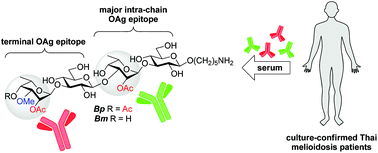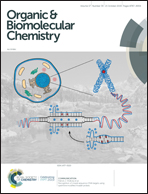Melioidosis patient serum-reactive synthetic tetrasaccharides bearing the predominant epitopes of Burkholderia pseudomallei and Burkholderia mallei O-antigens†
Abstract
Melioidosis and glanders, respectively caused by the Gram-negative bacteria Burkholderia pseudomallei (Bp) and Burkholderia mallei (Bm), are considered as urgent public health issues in developing countries and potential bioterrorism agents. Bp and Bm lipopolysaccharides (LPS) have been identified as attractive vaccine candidates for the development of prophylactic measures against melioidosis and glanders. Bp and Bm express structurally similar LPSs wherein the O-antigen (OAg) portion consists of a heteropolymer whose repeating unit is a disaccharide composed of D-glucose and 6-deoxy-L-talose residues, the latter being diversely acetylated and methylated. Herein we report the synthesis of two tetrasaccharides mimicking the main substitution epitopes of Bp and Bm LPS OAgs. The assembly of the tetrasaccharides was achieved using a sequential glycosylation strategy while relying on the late-stage epimerization of the inner rhamnose into a 6-deoxy-L-talose residue. We show that these synthetic compounds strongly react with culture-confirmed Thai melioidosis patient serum and closely mimic the antigenicity of native Bp OAg. Our results suggest that these tetrasaccharides could be suitable candidates for the development of vaccines and/or diagnostic tools against melioidosis and glanders.

- This article is part of the themed collections: Chemical Biology in OBC and Glycosylation: New methodologies and applications


 Please wait while we load your content...
Please wait while we load your content...